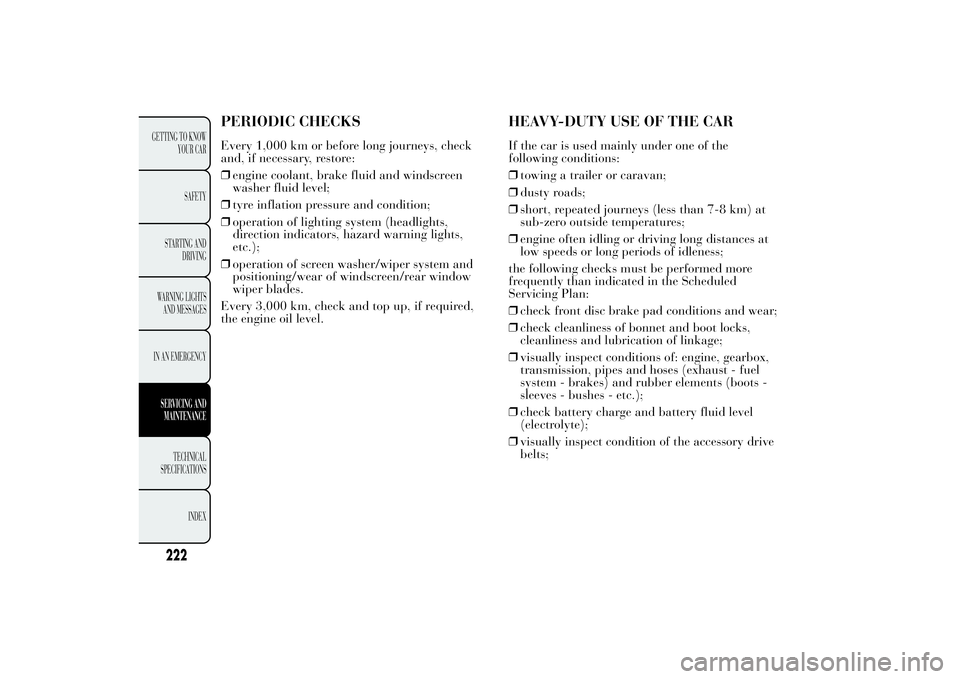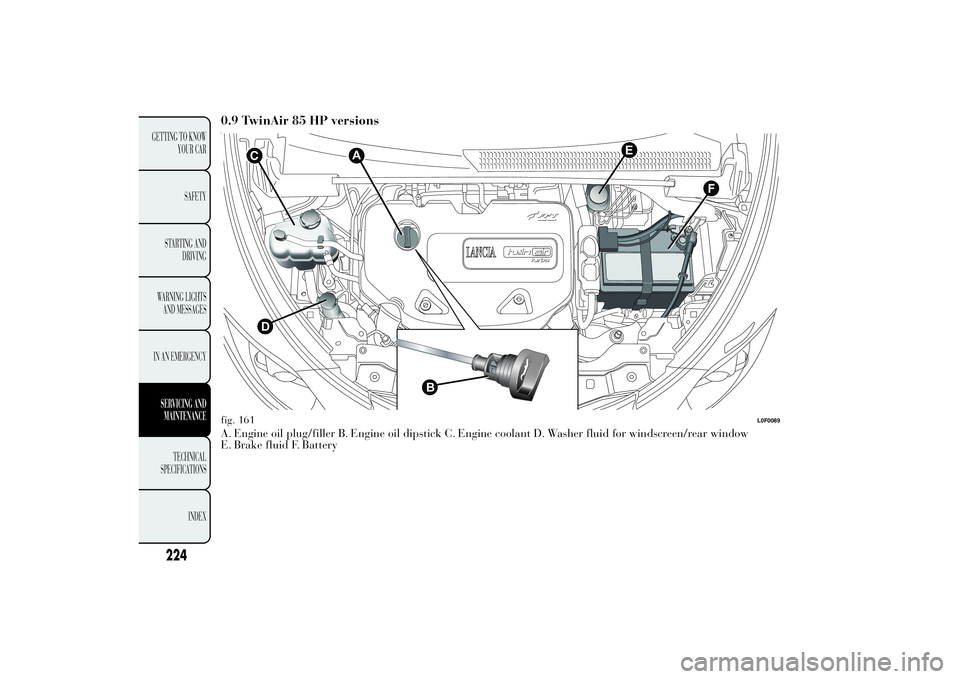battery Lancia Ypsilon 2014 Owner handbook (in English)
[x] Cancel search | Manufacturer: LANCIA, Model Year: 2014, Model line: Ypsilon, Model: Lancia Ypsilon 2014Pages: 315, PDF Size: 13.18 MB
Page 223 of 315

Thousands of miles 18 36 54 72 90 108
Thousands of km 30 60 90 120 150 180
Months 24 48 72 96 120 144
Check timing toothed belt conditions (excluding 0.9 TwinAir 85 HP engine)●●
Check tappet clearance and adjust as necessary (1.2 8V 69 HP version)●●●
Check handbrake lever travel and adjust, if required●●●●●●
Check exhaust gas emissions/smokiness●●●●●●
Check operation of engine management systems (using diagnosis socket)●●●●●●
Check gearbox oil level●●
Check battery charge status and possibly recharge●●●●●●
Replace spark plugs●●●●●●
Replace accessory drive belt(s)●
Replacement of timing toothed belt (0.9 TwinAir 85 HP engine excluded)
(1)
●
Replace air cleaner cartridge●●●
Replace engine oil and oil filter (or every 24 months)
(2)
●●●●●●
Change brake fluid (or every 24 months)●●●
Change pollen filter (or every 12 months)●●●●●●
(1) Regardless of the distance covered, the timing belt must be changed every four years for particularly demanding use (cold
climates, town driving, long periods of idling) or at least every five years.
(2) If the car's annual mileage is less than 10,000 km, the engine oil and filter must be replaced every 12 months.
219GETTING TO KNOW
YOUR CAR
SAFETY
STARTING AND
DRIVING
WARNING LIGHTS
AND MESSAGES
IN AN EMERGENCYSERVICING AND
MAINTENANCETECHNICAL
SPECIFICATIONS
INDEX
Page 224 of 315

DIESEL VERSIONS
Services must be performed every 35,000 km or24 months.Thousands of miles 21 42 63 84 105
Thousands of km 35 70 105 140 175
Months 24 48 72 96 120
Check tyre condition/wear and adjust pressure, if necessary●●●●●
Check operation of lighting system (headlamps, direction indicators, hazard
warning lights, luggage compartment, passenger compartment, glove●●●●●
Check operation of windscreen washer system and adjust jets if necessary.●●●●●
Check windscreen/rear window wiper blade position/wear●●●●●
Check cleanliness of bonnet and tailgate locks and cleanliness and
●●●●●
Visually inspect condition of: exterior bodywork, underbody protection,
pipes and hoses (exhaust - fuel system - brakes), rubber elements (boots,
sleeves, bushes, etc.)●●●●●
Check front disc brake pad condition and wear●●●●●
Check rear drum brake seal condition and wear●●
Check and, if necessary, top-up fluid levels (engine cooling, hydraulic
clutch/brakes, windscreen washer, battery, etc.)●●●●●
Visually inspect conditions of the accessory drive belt(s)●●
Check handbrake lever travel and adjust, if required●●●●●
Check exhaust gas emissions/smokiness●●●●●
220
GETTING TO KNOW
YOUR CAR
SAFETY
STARTING AND
DRIVING
WARNING LIGHTS
AND MESSAGES
IN AN EMERGENCYSERVICING AND
MAINTENANCE
TECHNICAL
SPECIFICATIONS
INDEX
compartment, instrument panel warning lights, etc.)
lubrication of linkages
Page 225 of 315

Thousands of miles 21 42 63 84 105
Thousands of km 35 70 105 140 175
Months 24 48 72 96 120
Check operation of engine management systems (using diagnosis socket)●●●●●
Check gearbox oil level●●●●●
Check battery charge status and possibly recharge●●●●●
Replace fuel filter cartridge●●
Replace accessory drive belt(s)●
Replace air cleaner cartridge●●●●●
Replace engine oil and oil filter (or every 24 months)
(1) (2)
Change brake fluid (or every 24 months)●●
Change pollen filter (or every 12 months)●●●●●(1) If the car is used mainly for town driving, the engine oil and filter should be changed every 12 months.
221GETTING TO KNOW
YOUR CAR
SAFETY
STARTING AND
DRIVING
WARNING LIGHTS
AND MESSAGES
IN AN EMERGENCYSERVICING AND
MAINTENANCETECHNICAL
SPECIFICATIONS
INDEX
( ) The actual interval for changing the oil and replacing the engine oil filter depends on the car usage conditions and is
signalled by the warning light or message (if present) in the instrument panel and must never exceed 24 months. 2
Page 226 of 315

PERIODIC CHECKSEvery 1,000 km or before long journeys, check
and, if necessary, restore:
❒engine coolant, brake fluid and windscreen
washer fluid level;
❒tyre inflation pressure and condition;
❒operation of lighting system (headlights,
direction indicators, hazard warning lights,
etc.);
❒operation of screen washer/wiper system and
positioning/wear of windscreen/rear window
wiper blades.
Every 3,000 km, check and top up, if required,
the engine oil level.
HEAVY-DUTY USE OF THE CARIf the car is used mainly under one of the
following conditions:
❒towing a trailer or caravan;
❒dusty roads;
❒short, repeated journeys (less than 7-8 km) at
sub-zero outside temperatures;
❒engine often idling or driving long distances at
low speeds or long periods of idleness;
the following checks must be performed more
frequently than indicated in the Scheduled
Servicing Plan:
❒check front disc brake pad conditions and wear;
❒check cleanliness of bonnet and boot locks,
cleanliness and lubrication of linkage;
❒visually inspect conditions of: engine, gearbox,
transmission, pipes and hoses (exhaust - fuel
system - brakes) and rubber elements (boots -
sleeves - bushes - etc.);
❒check battery charge and battery fluid level
(electrolyte);
❒visually inspect condition of the accessory drive
belts;
222
GETTING TO KNOW
YOUR CAR
SAFETY
STARTING AND
DRIVING
WARNING LIGHTS
AND MESSAGES
IN AN EMERGENCYSERVICING AND
MAINTENANCE
TECHNICAL
SPECIFICATIONS
INDEX
Page 228 of 315

0.9 TwinAir 85 HP versionsA. Engine oil plug/filler B. Engine oil dipstick C. Engine coolant D. Washer fluid for windscreen/rear window
E. Brake fluid F. Battery
F
E
CD
B
A
fig. 161
L0F0089
224
GETTING TO KNOW
YOUR CAR
SAFETY
STARTING AND
DRIVING
WARNING LIGHTS
AND MESSAGES
IN AN EMERGENCYSERVICING AND
MAINTENANCE
TECHNICAL
SPECIFICATIONS
INDEX
Page 229 of 315

1.2 8V 69 HP versionsA. Engine oil dipstick B. Engine oil plug/filler C. Engine coolant D. Washer fluid for windscreen/rear window
E. Brake fluid F. Batteryfig. 162
L0F0050
225GETTING TO KNOW
YOUR CAR
SAFETY
STARTING AND
DRIVING
WARNING LIGHTS
AND MESSAGES
IN AN EMERGENCYSERVICING AND
MAINTENANCETECHNICAL
SPECIFICATIONS
INDEX
Page 230 of 315

1.3 16V MultiJet versionsA. Engine oil dipstick B. Engine oil plug/filler C. Engine coolant D. Washer fluid for windscreen/rear window
E. Brake fluid F. Battery
E
A
CD
B
F
fig. 163
L0F0090
226
GETTING TO KNOW
YOUR CAR
SAFETY
STARTING AND
DRIVING
WARNING LIGHTS
AND MESSAGES
IN AN EMERGENCYSERVICING AND
MAINTENANCE
TECHNICAL
SPECIFICATIONS
INDEX
Page 234 of 315

BATTERYBattery F (see previous pages) does not require the
electrolyte to be topped up with distilled water. A
periodic check carried out at a Lancia Dealership
is, however, necessary to check efficiency.
REPLACING THE BATTERY
If necessary, replace the battery with another
original battery with the same specifications.
Follow the battery manufacturer's instructions for
maintenance.
USEFUL ADVICE FOR EXTENDING THE
LIFE OF YOUR BATTERY
To avoid draining your battery and make it last
longer, observe the following instructions:
❒when you park the car, ensure that the doors,
tailgate and bonnet are closed properly, to
prevent any roof lights from remaining on inside
the passenger's compartment;
❒switch off all roof lights inside the car: the car is
however equipped with a system which switches
all internal lights off automatically;
❒do not keep accessories (e.g. sound system,
hazard lights, etc.) switched on for a long time
when the engine is not running;
❒before performing any operation on the
electrical system, disconnect the negative
battery cable;
❒completely tighten the battery terminals.
230
GETTING TO KNOW
YOUR CAR
SAFETY
STARTING AND
DRIVING
WARNING LIGHTS
AND MESSAGES
IN AN EMERGENCYSERVICING AND
MAINTENANCE
TECHNICAL
SPECIFICATIONS
INDEX
IMPORTANT If the charge level remains under
50% for a long time, the battery is damaged
by sulphation, reducing its capacity and efficiency
at start-up.
The battery will also be more at risk of freezing
(this can happen as early as -10°C). Refer to
the paragraph "Car inactivity" in "Starting and
driving" if the car is left parked for a long time.
If, after buying the car, you wish to install
electrical accessories which require permanent
electrical supply (alarm etc.) or accessories which
influence the electrical supply requirements,
contact a Lancia Dealership, whose qualified staff
will evaluate the overall electrical consumption.
WARNING
Battery fluid is poisonous and
corrosive. Avoid contact with the skin
and eyes. Keep open flames away from the
battery and do not use objects that might
create sparks: risk of explosion and fire.
WARNING
Using the battery with insufficient
fluid irreparably damages the battery
and may cause an explosion.
Page 235 of 315

Incorrect installation of electrical and
electronic devices may cause severe
damage to your car. After purchasing
your car, if you wish to install any accessories
(car alarm, car phone etc.), contact a Lancia
Dealership, which will suggest the most
appropriate devices for your vehicle and will,
most importantly, advise you if a
higher-capacity battery needs to be installed.Batteries contain substances which are
very dangerous for the environment.
For battery replacement, contact a
Lancia Dealership.
WARNING
If the car will be unused for an
extended period of time in extremely
cold weather conditions, remove the battery
and store it in a heated area to avoid it
freezing.
WARNING
Always wear appropriate goggles
when working on or near the battery.
231GETTING TO KNOW
YOUR CAR
SAFETY
STARTING AND
DRIVING
WARNING LIGHTS
AND MESSAGES
IN AN EMERGENCYSERVICING AND
MAINTENANCETECHNICAL
SPECIFICATIONS
INDEX
BRAKESThe car is equipped with 4 mechanical wear
detection systems for brake pads: one for each
wheel assembly.
When the brake linings are about to wear out,
pressing the brake pedal, a light hiss is heard: this
indication lasts around 100 km (depending on
the driving style and the route type).
In these circumstances it is still possible,
proceeding with caution, to carry on driving.
In any case, contact a Lancia Dealership as soon
as possible to have the worn brake pads replaced.
Page 291 of 315

SPEED VOLUME function
(speed-based volume change)
(excluding versions with 360° HI-FI MUSIC
system)
This function automatically adapts the volume
level to the speed of the car, increasing the volume
when the speed increases to maintain the ratio
with the noise level inside the passenger
compartment.
To turn the function on/off, press the
/
buttons. The words "Speed volume" appear on
the display, followed by the current status of the
function:
❒Off: function deactivated
❒Low: function activated (low setting)
❒High: function activated (high setting).
RADIO ON VOLUME function
(radio volume limit activation/deactivation)
This function makes it possible to
activate/deactivate the volume limits when the
radio is turned on.
The display shows the function status:
❒“Radio on vol – Limit on”: when the radio is
switched on the volume level will be: – if the
volume level is equal to or higher than the
maximum value or higher, the radio will come
on at the maximum volume;– if the volume level is between the minimum and
maximum values, the radio will come on at the
same volume as before it was switched off
❒"Radio on vol – Limit off": the radio will come
on at the volume level it was at before switching
off. The volume level can be between 0 and 40.
To change the setting of the selected function, use
the
/
buttons.
NOTES
❒Using the Menu it is only possible to adjust the
activation/deactivation of the function and not
the minimum or maximum volume value.
❒If the "TA" or "TEL" functions or an outside
audio source are activated when the radio is
turned on, the radio will come on at the volume
set for these sources. The volume can be
adjusted between the minimum and the
maximum level, by deactivating the external
audio source.
❒If the battery charge is low, it will not be
possible to adjust the volume between the
minimum and maximum levels.
287
SOUND-SYSTEM